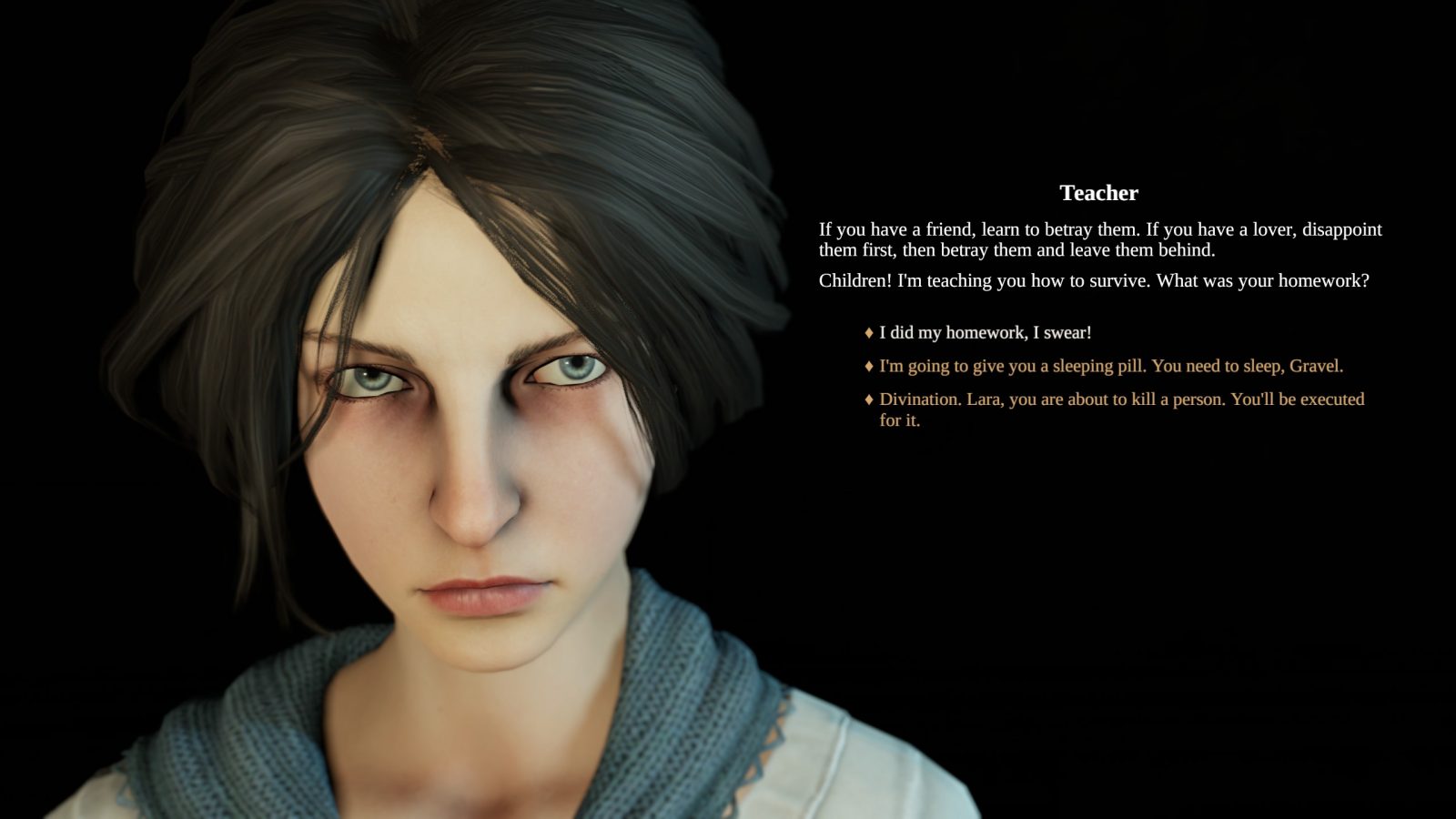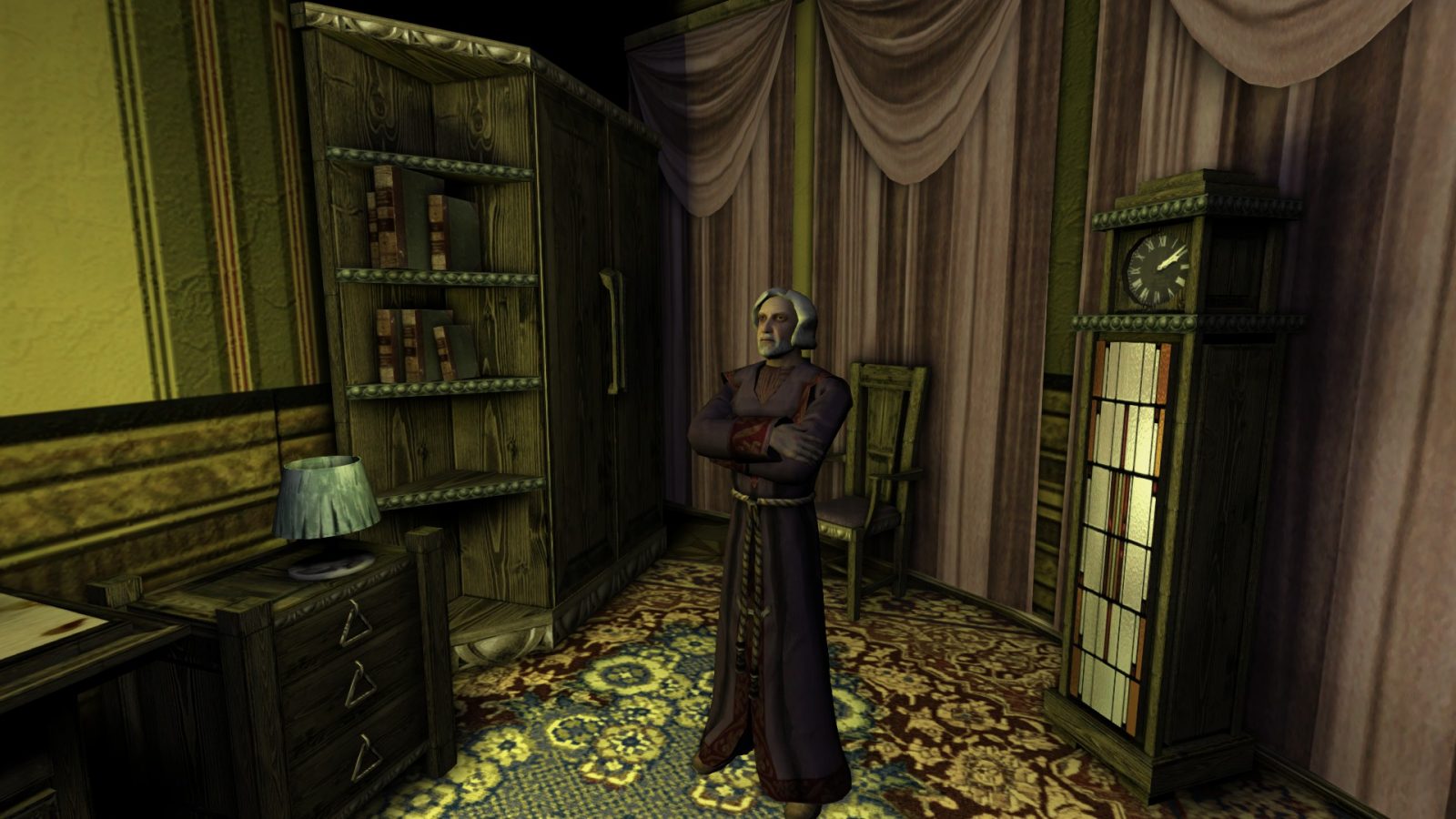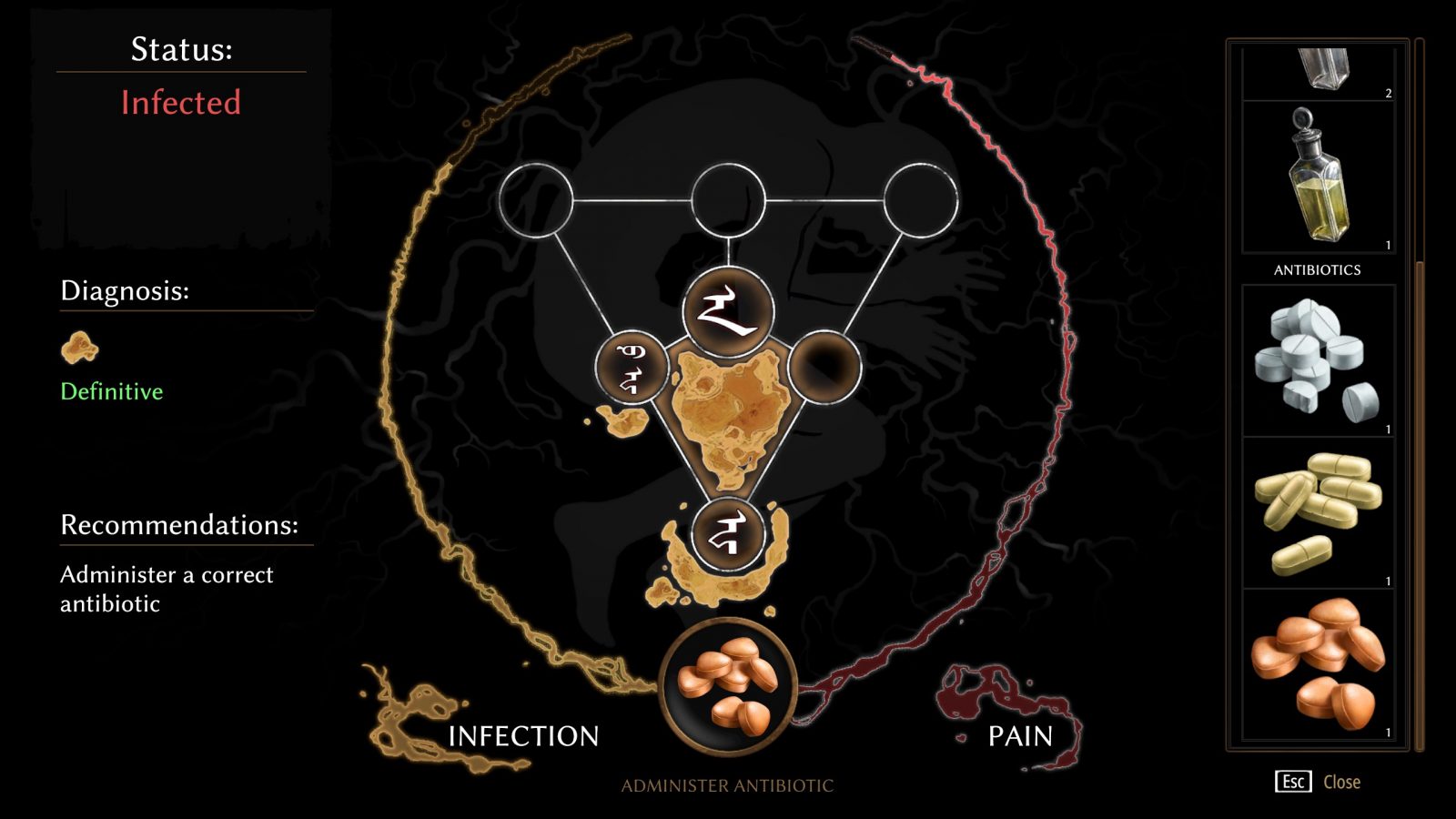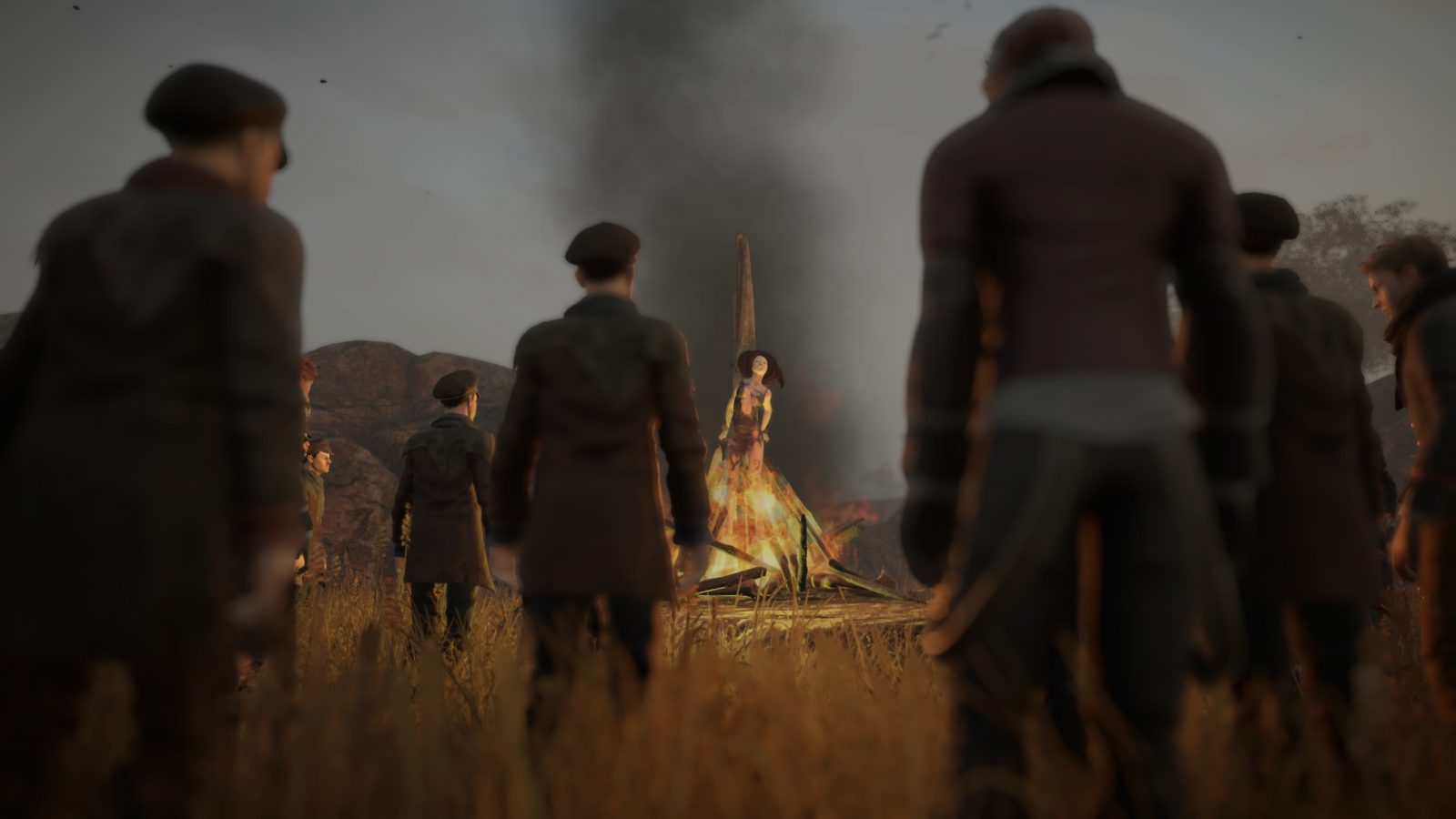Three healers arrived in town today. The Bachelor Daniil Dankovsky, who meets with an immortal man to defeat death. The Haruspex Artemy Burakh, returning home at the behest of a dire letter from his father. And finally, the Changeling Clara, who knows all. You can take on the role of one of these souls in the coming performance over the course of 12 days. A plague called the Sand Pest infests this theater of cruelty, and your performance will determine the town’s ultimate fate.
Pathologic is an incredibly interesting game. Developed by Ice Pick Lodge, this 2005 survival game was called a “suffering simulator” due to its difficulty which, to put it lightly, would kick the player while they’re down, set them on fire, and spit on them to put the fire out. It was a miserable experience that dared to do things and go places most games, and media in general, are afraid to even mention. However, it hasn’t aged particularly well; many mechanics are left completely unexplained, your character moves slower than a snail through a large space, and despite being translated from Russian twice it can still be extremely difficult to tell what’s going on. It’s dense, messy, mean, and comes highly recommended if you’re interested in games as art. Although that comes with the caveat that you may want to watch a video or two dissecting the game along with your playthrough or if you bounce off of it. Two suggestions would be Harry Brewis’ Pathologic is genius and here’s why and Ruby Seals’ Pathologic, for those who will never play it two-parter.
For everyone else though, just play Pathologic 2.
I mean it, right now. Just go play it, you don’t need to read the rest of this if anything I’ve said so far is interesting. Pathologic 2 might just be one of the greatest games ever made, it removes the friction from the original while expounding on the ideas presented there to an astounding degree. If Pathologic was already a flawed masterpiece, 2 somehow blows it out of the water despite only having the Haruspex’s route. It is an incredible experience that will stick with you for a long, long time. If you still need more, however, I’m happy to soliloquize.
Our play begins the same place all do, on the stage. In Pathologic 1, you observe a discussion between our three leads on their vastly different approaches to healing the sick. Eventually, they conclude that they cannot work together, and you are left to decide which role to adopt: the Bachelor, the Haruspex, or the Changeling. The Bachelor is the easier route, focusing on developing a vaccine to the plague, while the Haruspex is much more difficult in discovering a cure. The Changeling is only unlocked after finishing one of the other two routes and is… well, it’s really weird and honestly feels rushed and unfinished even if it does delve deeper into revelations at the end of the other two routes. Whichever character you choose to play before the plague hits you will be presented with a list of townspeople who are bound to you. In addition to completing each day’s main quest, keeping all of your Bound alive is required to reach a proper conclusion.

Pathologic 2, however, begins at the end of the first game. The three protagonists have failed to contain or cure the epidemic in any way, and Artemy rushes to the town’s Cathedral to stop the army from bombarding the town to prevent it from becoming a pandemic. His efforts are fruitless, and the play’s director emerges to admonish you, the player and actor, for failing in your role. You then demand a do-over(or really, a first try) and he acquiesces. After a short dream sequence introducing you to Artemy and the town, he arrives by train and his introduction continues as normal. Pathologic 2 is essentially an expanded remake of the Haruspex’s route, though with a much more open main quest along with a heap of new content. It does have some themes and ideas in common with the original, but mostly explores new territory. With only one route available as of writing (with a DLC where you play one day as the Bachelor), the two games essentially support each other’s shortcomings in terms of narrative fullness.
As you explore the town-on-Gorkhon, you’ll need to manage various meters to keep yourself alive. Health is fairly obvious, it goes down when you get stabbed, shot, or otherwise injured and if it hits 0 you die. Hunger requires you to eat or starve to death, and likewise, you need to sleep occasionally to keep Exhaustion down. Finally, Immunity and Infection come as a pair; the more immune you are, the less likely you are to get infected in the first place or, failing that, slow the rate at which the infection ravages your body. To contextualize why you can, for example, become starving within a matter of hours, the September air of the town slowly kills you. So that’s fun. Pathologic 2 also introduces stamina, which allows you to sprint. Sprinting will also decrease your maximum stamina over a longer period of time, which you can restore by drinking water.
In general, I don’t like passive survival mechanics. Having to manage multiple meters while just trying to go about my business can feel tedious and usually doesn’t connect well to the rest of the gameplay or themes. I still think the best implementation of these kinds of mechanics is in Days Gone – you use up each resource as part of normal, active gameplay instead of them decreasing in the background. However, this type of management works to enhance Pathologic’s gameplay, story, and themes perfectly. Because you also have to take care of yourself, it may give you pause when planning out your day. Do I have time to visit a friend and get some food, or do I risk starvation to increase the chances of a child surviving another day? Do I fill up my water bottles here to brew some medicine at home, or use it to keep my stamina up? Do I risk catching the plague to treat this person? The whole game is about making decisions like this, getting the most out of your time and resources while also staying alive to see the sun rise once more.
Pretty much everything in both games is working against both of those goals. People will constantly lie to you to waste your time and energy or advance their own agendas. You can’t trust anyone, but you have to trust someone and hope that trust is not misplaced. The game works on a 24 hour clock, so your time is limited and thus you cannot possibly do everything nor save everyone. That being said, there are multiple outcomes to events and making mistakes may lead to a more interesting playthrough.

As you go about your business, you’ll encounter certain hazards. Some individuals take to the streets in the chaos and begin attacking pretty much anything that moves and, eventually, once the army arrives they might start hunting you down too. Oh yeah, and there’s the Sand Pest, which will infect random districts each day. When simply walking around an infected district, your immunity will slowly decrease and infection increase. Interacting with objects or people in these locations has a chance to contaminate you as well, though these districts also allow you to freely loot without a loss to your reputation, which we’ll get into in a bit. In addition, a specter of the Sand Pest will roam the streets or even chase after you, causing a big burst of infection if touched. Infected districts offer the comparatively greatest rewards for the greatest risks, but what you find won’t last you long and treating an infected Bound may still result in their death at the end of the day.
Speaking of treatment, while in Pathologic 1 you simply give the Executor (people in bird-like costumes) outside of a person’s door drugs to administer to the sick inside, Pathologic 2 expands on this greatly. The only cures to the plague are the Panacea you can create, a mysterious compound called a Shmowder, which is a mix of various drugs put together by children and is impossible to reverse engineer, or the Changeling can miraculously heal people with her attack (you can also cure yourself of the Sand Pest by lighting yourself on fire for a brief moment. Obviously, this is not recommended, but if it works it works). Both are exceedingly rare, so for most patients you can lower their infection, and chance of death, by giving them the color of pill that matches their infected area. The Sand Pest can infect one of three parts of an infected person: Bones, Nerves, and Blood. Using tinctures brewed from herbs you can collect in the wilds on someone will reveal the infection surrounding that area along with one or two tiles connecting to the other layers. Using one or more tinctures, you can make a guess at what color pill the patient needs to reduce their infection. Incorrect treatment will still lower infection somewhat, but seeing as infection level directly corresponds to a person’s chance of death at the end of each day you’ll want to do your job correctly.

Doing good deeds like healing people will increase your reputation in a district while generally being an asshole or murdering people will decrease it. If you let your reputation get too low, people will refuse to trade with you (the primary way of getting items outside of shops) or eventually try to kill you in the streets. The Bachelor’s reputation starts decently high and can be easily kept that way, while the Changeling’s starts low and is constantly decreasing. Meanwhile, the Haruspex’s starts at rock bottom having to kill three men in self defense upon arrival and can be very difficult to increase because everyone immediately wants to beat you to death. You can think of reputation as the consequences of your actions, making things easier or harder depending on what you prioritize.
If you couldn’t already tell with my explanation of mechanics going on 3 pages now, there’s a lot to keep track of here. There’s no shortage of things to do and decisions to make, and those will be presented by fantastically written characters. I do wish there was full voice acting, but there is a LOT of text here, at least a dense novel’s worth, and that’s an unreasonable ask of an indie studio. The writing itself is very smart and invokes various philosophical concepts, perspectives, and ideas in theater that all connect in fascinating ways. The game perhaps takes most inspiration from the concept of the Theater of Cruelty, which to grossly oversimplify is the idea of a play being an assault on the senses of the audience. I don’t claim to be a philosopher or to really understand all of these things, but regardless it will get you thinking in new ways and feeling things you wouldn’t be able to without the horrors on display here. Media allows us to experience situations we wouldn’t normally want to from the safety of a page or screen, and I think Pathologic provides a very valuable experience indeed. The horrible things you’re often forced to do, let happen, or see, really get you thinking, and the emotional exhaustion that comes from playing the game can push you to your limits. I’m not afraid to admit I had to take several breaks in my playthroughs just to calm down, which is something no other piece of media has done to me before.

With all that said, I wouldn’t consider Pathologic 1 or 2 to be “fun” in the traditional sense. For example, the combat in both games is straight-up awful, probably by intention. Seeing as you’re essentially a normal person in all three routes, it makes sense that your character can’t shoot or fight well and so disincentivizes engaging in combat. Despite this, there are several moments the game forces you to fight, which really suck. In 1, it’s not so bad because you can just save-scum your way through, but in 2 each death permanently affects your character by reducing your maximum stats or can unleash bad things into the world. These persist throughout your profile even if you reload a save and, given that you can only save at clocks in this version, can become very annoying if you find yourself stuck just outside a combat encounter you can’t possibly win. I had to use the command console to get by one of these because the peaceful route glitched out on me. I think these forced encounters could have been removed without adversely affecting the story. The combat is supposed to reinforce your powerlessness in this situation, but it more often becomes a stonewall to progress relying on luck or manipulating the AI. In fact, with regards to powerlessness, I actually felt more empowered with the ability to do something, save someone, in the face of a deadly plague. It’s an interesting feeling that is clearly not intentional, but nonetheless brought about by the bleak times we live in.
Even having gone through all that, I still want to play more eventually. I can’t stop thinking about what these games have to say and I want to know other people’s interpretations. I don’t think I’ll dive back in for a while, but it is an absolutely fascinating experience that deserves more attention. Pathologic 2 is by far the better game, the HD Classic’s jank isn’t unbearable but I hope they add the other two routes to the game, preferably expanding on the Changeling’s especially. Games are in a unique position artistically with the ability to convey feelings and ideas through difficulty of play, and I think more games should explore this avenue of storytelling.
















